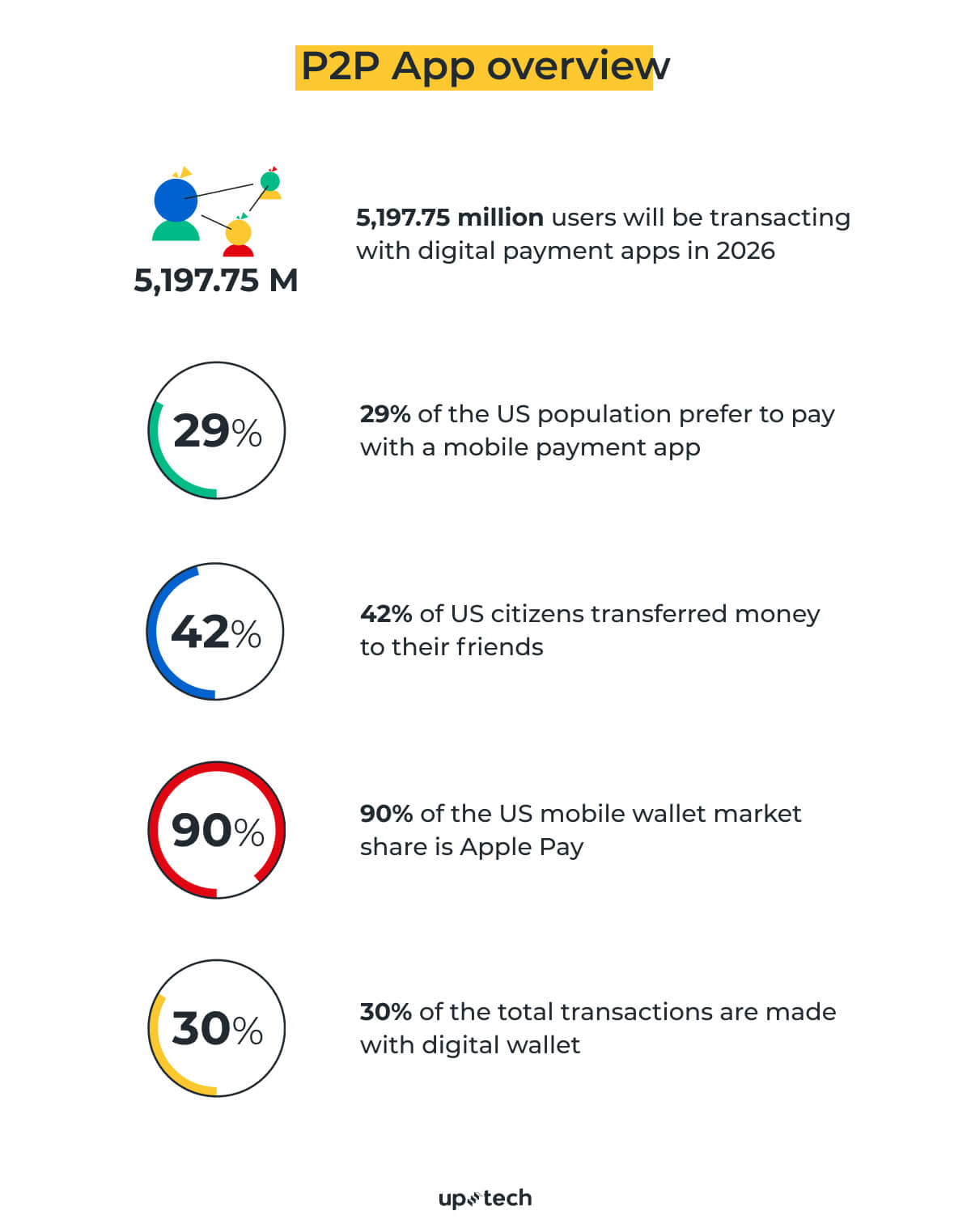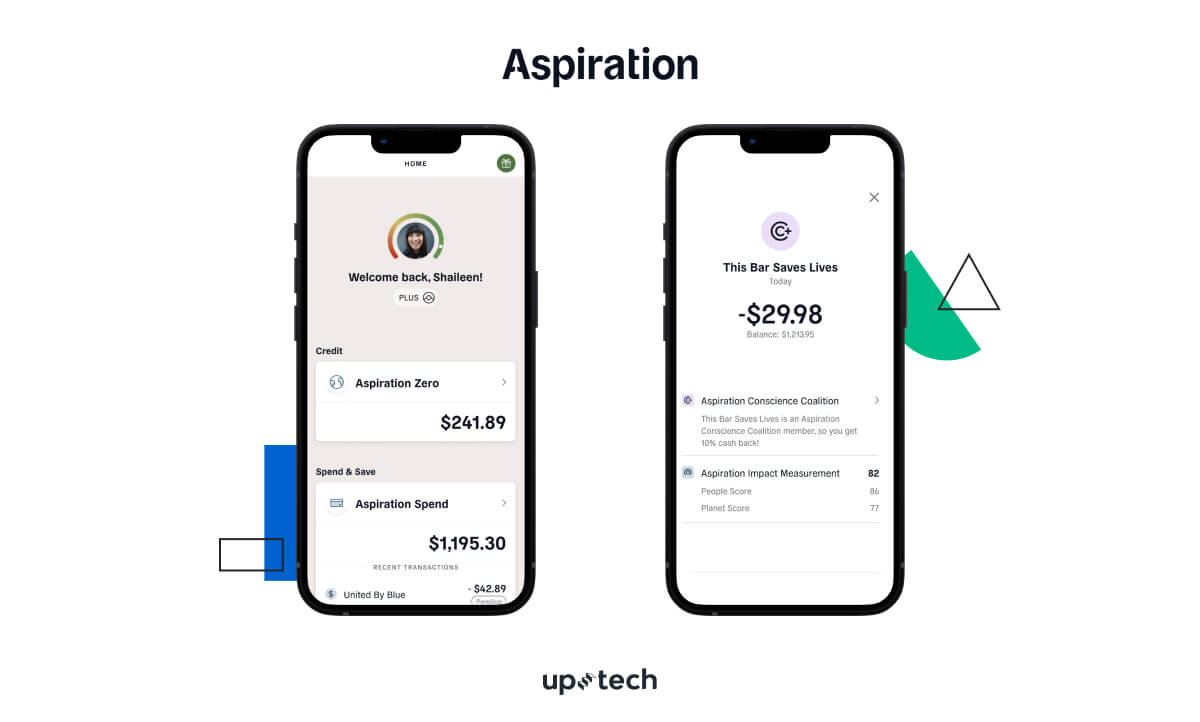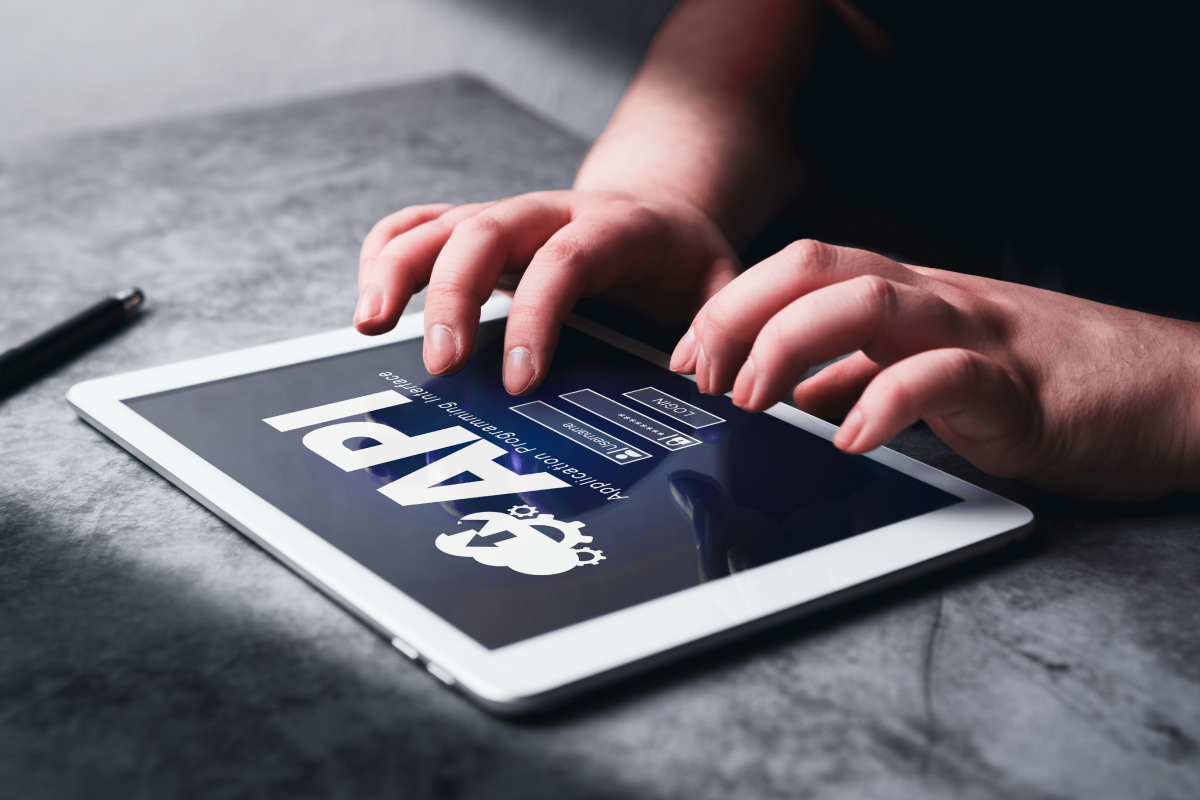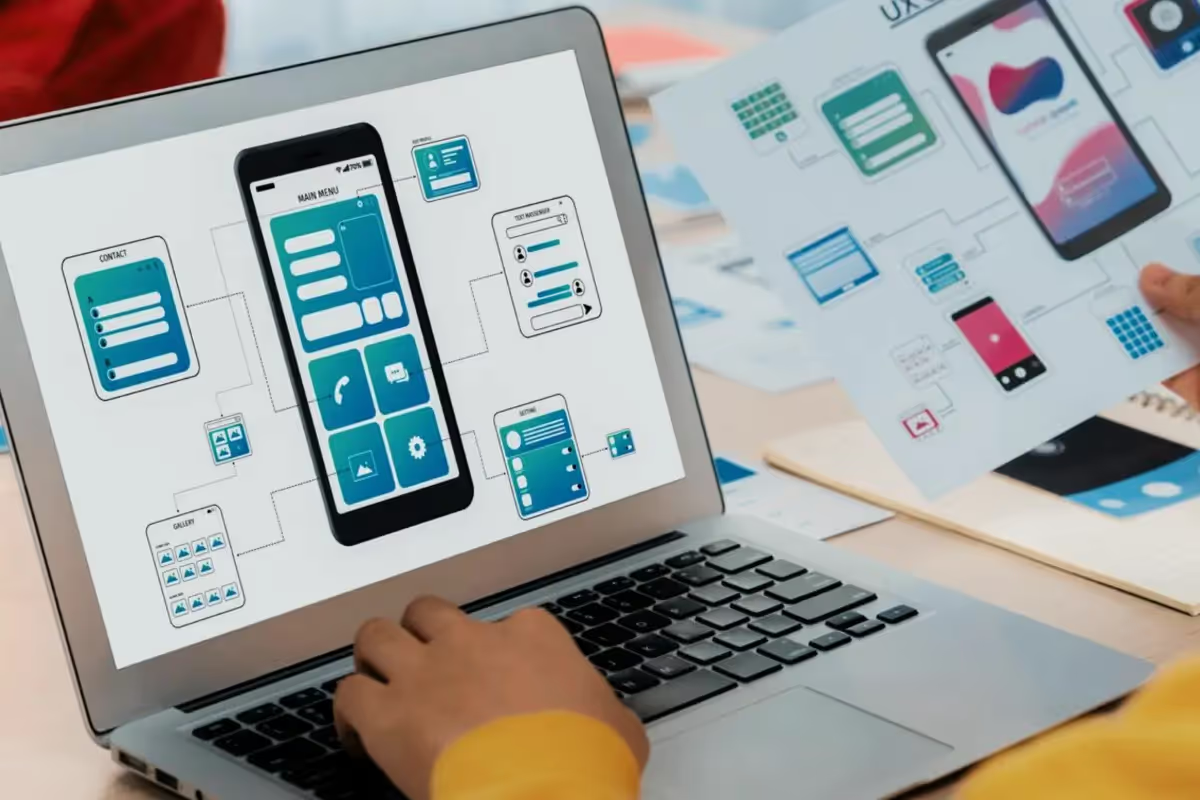The fintech industry is booming, and understandably, startups hope to capitalize on the changing financial landscape. There’s a growing interest in payment apps development because digital payments remain the most popular segment among fintech markets. According to statistics, the total transaction from payment apps will amount to US$8,563 billion in 2022.
Developing a P2P payment app is not easy as you’ll need to overcome many technical, security, and legal hurdles during the process. In this article, I’ll explain the challenges and our approach to building secure payment apps.
What is a P2P Payment App
A P2P payment app is a digital platform that allows users to send money to ‘peers’, which are friends, families, or in some cases, retailers. Peer-to-peer (P2P) apps provide the convenience of instantly transferring money between both parties without going through intermediaries.
The idea of cashless banking has enjoyed a popular reception during the Covid-19 pandemic. People opt for a more hygienic option that does not involve physical cash. Payment apps allow them to connect and load an e-wallet with money from their bank or credit card, which enables cashless transfer to friends or retailers.
Paypal is one of the earliest digital payment platforms facilitating P2P money transfers via email. While it remains a popular option, the fintech revolution has seen newer competitors, offering distinct features with P2P transactions at its core. For example, Zelle, Cash App, Google Pay, and Apple Pay are notable payment apps that have emerged over the years.
P2P App Quick Stats

Check out these interesting figures if you need more convincing reasons to build a P2P payment app.
- More than 5,197.75 million users will be transacting with digital payment apps in 2026.
- The is still a vast untapped market for digital financial products, as 31% of adults have yet to own an account in 2017.
- 29% of the US population prefer to pay with a mobile payment app all the time, according to a survey in 2021.
- 42% of US citizens transferred money to their friends and acquaintances in 2021.
- Apple Pay will dominate the US mobile wallet market share in 2020 by more than 90%.
- Digital wallet is the top payment option for e-commerce in the US and accounts for 30% of the total transactions.
Looking for financial software development services? We are here to help you. Contact us.
How Payments App work
Despite its convenience, the inner-working of a payment app is complicated. Different payment apps might use different authentication, security, and payment gateways, but they share fundamental principles. Most P2P payment apps incorporate a digital wallet, where you deposit funds from bank accounts or credit cards.
For P2P transactions there are two options.
First one, both parties must install the same payment app on their mobile devices. When you send payment to your friend, you would need to insert personable information, such as an email or mobile number. The transferred amount is deducted from your e-wallet and credited to the recipient’s payment app.
But sometimes it's enough to have the app only for the sender. It’s the second option for P2P transactions. Sender inputs a receiver credentials in the app. So the beneficiary receives a link and can pass through the flow just on a web page.
Using payment apps for in-store purchases involves a different transfer mechanism. There are two ways of facilitating payment to retailers, i.e., NFC and QR code. NFC involves transferring payment details with ultra short-range radio frequency to a payment terminal. Meanwhile, a QR code contains a unique ID that identifies a specific party in the transaction.
NFC is the dominant payment model in the US, UK, and Western countries. Payment apps like Apple Pay and Google Pay use the NFC capability in smartphones to make payments to the retailer’s payment terminal. Meanwhile, QR code payment is prevalent in the APAC region, with Chinese-based Alipay leading the pack.

Regardless of the payment technologies, the payment transfer involves sending encrypted information to the payment processor, credit card issuers, or banks. This is done in a highly-secure channel between the parties to ensure the transaction integrity is not compromised. In simpler words, the right amount is deducted from the sender’s e-wallet and added to the recipient’s balance at all times.
What Are The Different Types of P2P App
Before you pursue P2P app development, it's essential to understand the different variants and the market they serve.

Standalone payment app
These apps are a self-encapsulated ecosystem that frees users from banking infrastructure. Paypal, Venmo, Square Cash, and Alipay are prominent apps that use this standalone model. Users deposit money from their bank account to the app's e-wallet, and they're free to transfer the funds with users who use the same app.
Foreign exchange payment app
As the name implies, the payment app allows users to transfer money to their peers, except in foreign currencies. Wise, which supports 25 different currencies, is popular amongst users because of its lower exchange fees compared to banks.
Bank-centric payment app
Banks have shown tremendous interest in the P2P app segment, and some payment apps are built with existing banking infrastructure in mind. For example, Zelle is a popular P2P app that integrates with most US banks, allowing users to make cashless purchases with retailers.
Social media-based payment services
Popular social media platforms are testing out the viability of doubling as a P2P payment app and hope to replicate the success of WeChat. Facebook Pay is available in the US, where users can send payments to their contacts without leaving the app. Meanwhile, Whatsapp runs a trial in India where users can send and receive money via a UPI ID or QR code.
Mobile OS payment services
Key players in the mobile industry have built their respective P2P digital payment ecosystems. Apple Pay, Samsung Pay, and Android Pay target users of their respective devices with payment services based on intrinsic hardware capabilities like NFC.

Common Pitfalls Of Developing Payment App
I have to be frank that building a P2P payment app is considerably more challenging than other commercial apps. Some concerns must be addressed early on as they’ll affect the eventual release of the app.
Fraud risks
Payment apps are crucial financial touchpoints, and users may hold thousands of dollars in their e-wallets. It is vital to ensure the app is protected from unauthorized access, which might result in fraudulent activities. Besides introducing safeguards like two-factor authentication, developers must also ensure that payment data is encrypted when transmitted between terminals, servers, or devices.
Data security
Users trust P2P payment providers to protect their privacy at all costs. It will be detrimental if the personal information, transaction history, or sensitive financial data are exposed to malicious actors. Service providers must employ preventive measures, such as enforcing cloud security and displaying a clearly-worded privacy policy.
Regulatory compliance
Every functionality introduced in the app must comply with regulatory bodies to operate legally. For example, it’s mandatory for payment apps that collect credit card data to adhere to the PCI DSS. Payment apps must also maintain strict adherence to Know-Your-Customer regulations, such as FinCEN’s CDD rule to prevent money laundering.
Growth bottlenecks
What follows a successful release is increased exposure and an exponentially growing user base. If your payment app isn’t built with scalability in mind, it will experience bottlenecks and lead to service disruptions, instability, and a high churn rate.
Plan for the eventual growth of your app by using scalable cloud infrastructure, technological modules, and microservices. Implement a separate financial calculation module to avoid the excessive burden of the core payment system.
Technological gaps
Developing a P2P payment app requires the combined effort of expertise in different software disciplines. It is not an effort that you can delegate to a freelancer but requires a team of highly-experienced developers. A payment app consists of multiple interlinking modules, such as an e-wallet, blockchain, encryption, APIs, data warehouses, and other emerging technologies.
Versatility
Mobile payment is a fintech segment that has dynamically-changing requirements. While it’s essential to support basic payment options, it’s equally crucial to understand consumer behaviors and finetune the app accordingly. For example, a strictly P2P-only app might need to integrate with ride-hailing providers or risk losing relevance.
Must-have Features for Payment App
These features are critical to ensure that your payment app possesses the basic functionalities to serve its users adequately.
Send and receive money
Users have the flexibility to transfer any available amount in their e-wallet to the intended recipient. Likewise, they can receive money from senders from other users.

Spending Analytics
This feature allows users to review their expenses over a specific duration and plan future spending. Some payment apps include Saving Goals and Cashback, which are helpful for encouraging responsible spending.
Notification
The app sends immediate notifications for financial transactions, account activities, and other events of interest.
Payment and invoicing
These value-added features allow users to pay bills from external service providers or send invoices to customers to initiate payment collection.
Transaction history
The app must maintain immutable records of past transactions and provide filters that allow users to select specific transactions and periods.

Multi-Factor Authentication
OTP, PIN, and biometric validation prevent the payment app from being abused by unauthorized parties. These security token also ensures that users do not accidentally initiate fund transfers.
Transfer
Users can perform money transfers locally or in foreign currencies to various payment gateways, banks, and service providers.
Banking integration
Besides P2P transfer, introducing the capability of sending funds to bank accounts makes the app more user-friendly.
Biometric identification
A fingerprint lock is an excellent secondary safeguard to prevent anyone from launching the payment app. It protects users’ privacy and prevents accidental exposure of sensitive financial records.
Text messaging
An interactive messaging module for P2P lending and social-oriented apps is helpful for connecting with fellow users. It keeps conversations contained and relevant to monetary transactions.
Customer support
An AI-based chatbot and knowledgebase help guide users to solutions when they face technical, transactional, or other problems on the app.
6 Steps to Build a Payment App
Building a successful payment app takes careful preparation, execution, and improvisation. Here's how to do so.
Step 1 - Discover the market and conduct technical research
As the founder, you must have a clear perspective on the problems you're trying to solve and ensure there's a demand for your products. This means studying the digital payment market you have set your sights upon. Analyze what your competitors are doing and determine how to add value to the highly-competitive payment app market.
It’s also equally important to conduct deep technical research as a payment app is dependent on robust security, technological integration, and regulatory compliance. You must explore the available tech stacks and evaluate if they are sufficient for developing a technical-sound payment app.
Still have questions on how to conduct initial research? Check out our article on Discovery Phase
Step 2 - Choose the P2P app type
Then, decide the P2P app type that aligns with your business value, goals, and solution. For example, some founders are not keen on taking the likes of Paypal and Alipay in the standalone app segment, but they are intrigued by P2P lending's growth potential in the coming years.
Step 3 - Study your audience
You might introduce revolutionary ideas to the fintech space. Unless your audience agrees with your thoughts, you're on shaky grounds when developing the app. Run feasibility studies, conduct interviews, and hold surveys to ensure you're building an app that offers real value to users.
Getting on the ground with users helps you reduce the risks of launching a new app. Based on the interactions, you'll better understand important features, major pain points, and overlooked opportunities that help build an app that users want.
Step 4 - Create the design
The design phase starts by structuring the feasibility findings into mind maps that paint the overall picture of the app. Based on the specification, developers work on the app's UX and UI while aligning the process with the business goals. They produce artworks depicting the layout of the app screens and optimize user interaction with various elements on the app.
By the end of this step, you will have a set of visually-appealing screen layouts and descriptive user journeys that help users achieve their goals efficiently. The idea is now represented in interconnected code wireframes, awaiting further development in the next step.
Step 5 - Build the MVP
It's prudent to test the market with an MVP instead of launching a full-blown feature-laden app. This is the stage where developers are involved in coding, technology integrations, and testing to produce a functional app for users.
Often, building a payment app requires expertise in API integration to connect the app with different cloud services. Blockchain and AI are also common fintech technologies that act as the foundation of the payment mechanism.
Developers work in small iterative sprints to solve bugs and revise the app based on testing results. It's also essential to involve users in testing the MVP. Their feedback is valuable in ensuring that the app is heading in the right direction.
Step 6 – Launch & Improve Constantly
Launch your payment app with optimism but be watchful for potential issues. Monitor feedback and analytics to identify bugs and expedite fixes. Even if you have managed to iron out teething issues, it's vital to improve the app based on changing trends. Engage your developers periodically about introducing new features or modifying existing ones to meet market demands.
How Uptech Can Help to Build Payment Apps
Uptech has a long-standing record of helping startups develop and launch successful payment apps to the market. Our team consists of multi-disciplinary software experts skilled in fintech technologies necessary to create digital payment solutions. Our in-house expertise includes blockchain, smart contracts, and AI, some of the most critical technical skills for the growing fintech market.
Besides building cutting-edge solutions, we consider the human part of the equation in earnest. We conduct feasibility studies and usability tests and leverage the feedback to produce apps that engage with user needs. Furthermore, we understand time sensitivity, budget, and business goals alignment for our clients.
In other words, Uptech converges technologies, teamwork, and valuable opinions to build successful P2P payment apps. One of our finest works is Aspiration, a socially-conscious virtual bank with zero-fees transfer facilities. Our team helped the US-based startup realize its idea from scratch with brainstorming, validation, coding, testing, and post-launch support sessions.
.jpeg)
Summary
I’ve shown you everything you ought to know about building a P2P payment app. Launching a successful digital payment app takes considerable effort, but an adept development partner smoothens the journey. Considering that fintech is still a fast-growing industry, you’ll want to take advantage of every opportunity.
We’ve shared similar success with our clients, and we’re confident that we could do the same for you. Talk to us and get your journey started.




































































































